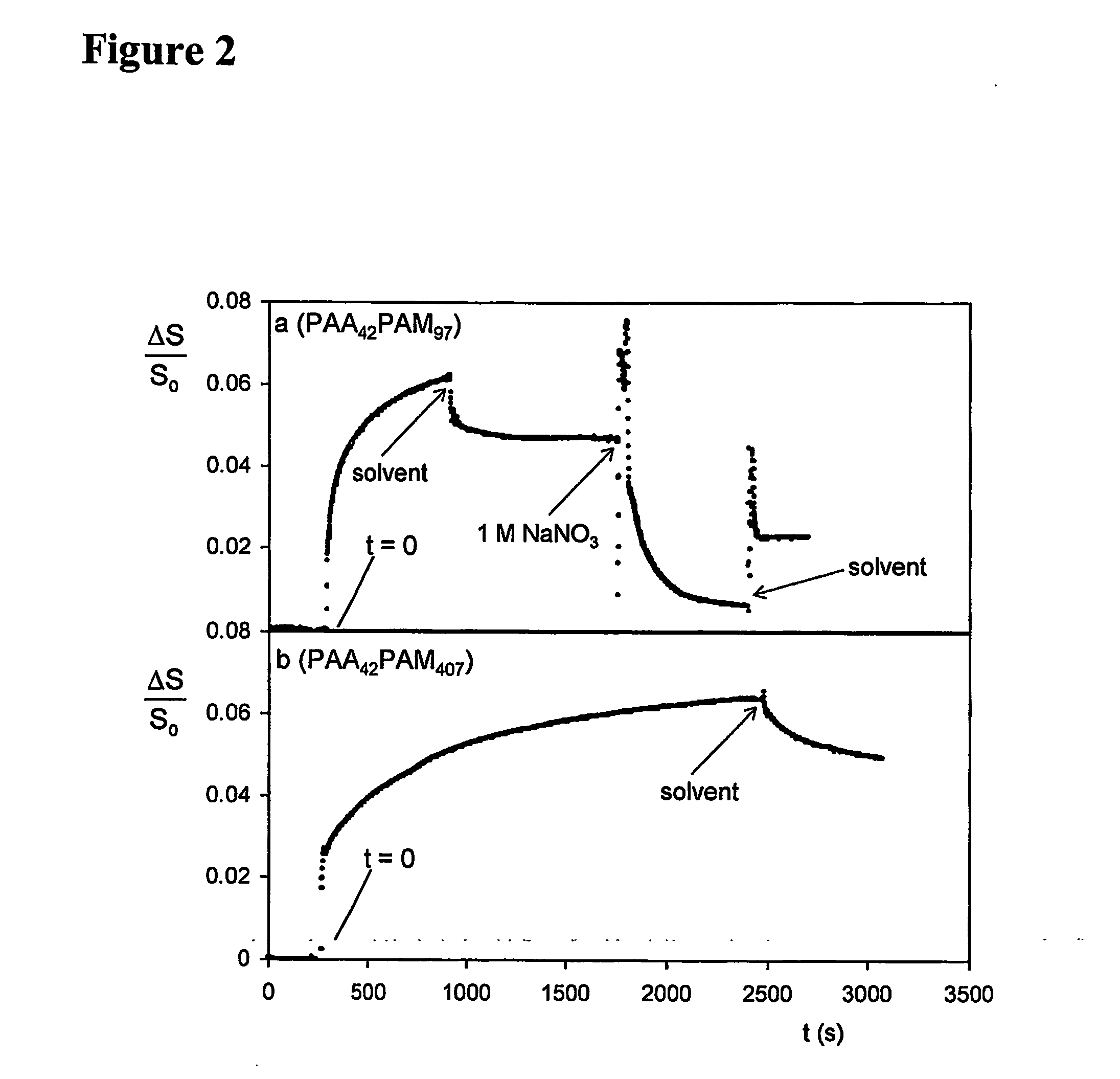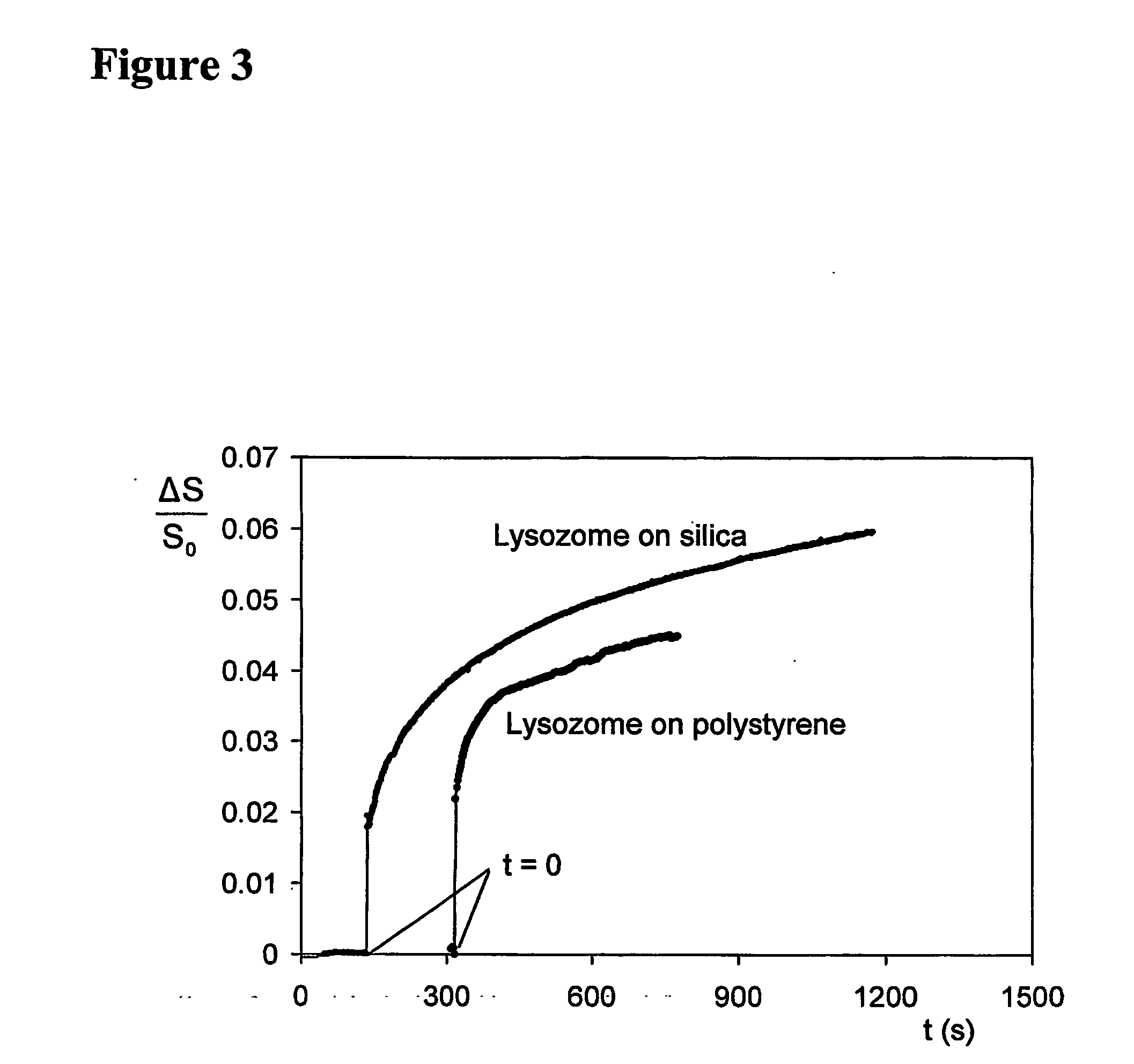Complex coacervate core micelles as surface modification or surface treatment
a coacervate core and core micelle technology, applied in the field of modified or treated surfaces, can solve the problems of affecting affecting the appearance of the surface, and the application of polymeric micelles with amphiphilic character is restricted to a limited number, so as to prevent bacteria proliferation, prevent malodour, and suppress odour. , the effect of preventing malodour
- Summary
- Abstract
- Description
- Claims
- Application Information
AI Technical Summary
Benefits of technology
Problems solved by technology
Method used
Image
Examples
example 1
[0272] Poly(N-methyl-4-vinylpyridiniumjodide (PVP) was used as obtained from Polymer Source Inc. (Montreal, Canada). 0.5 g PVP was dissolved in 10 mM aqueous solution of NaNO3 to a concentration of approximately 0.5 g / l. Separately, two batches with poly(acrylic acid)-co-poly(acryl amide) under the name of PAA42-PAM97 and PAA42-PAM417 were prepared by dissolution of 0.5 g PAA42-PAM97 and 0.5 g PAA42-PAM417 in 10 mM NaNO3-solutions to concentrations of about 0.5 g / l. and 1.5 g / l. respectively.
[0273] PAA42-PAM97 is a diblock copolymer comprising a block having about 42 units deriving from acrylic acid, and a block having about 97 units deriving from acrylamide. PAA42-PAM417 is a diblock copolymer comprising a block having about 42 units deriving from acrylic acid, and a block having about 97 units deriving from acrylamide. The diblock copolymers can be obtained for example by process substantially described in document ???? with adjusting the amounts of monomers used.
[0274] The frac...
example 2
[0278] The titration experiment of example 1 was repeated with the batches of 10 mM NaNO3 solutions of PAA42-PAM97, PAA42-PAM417 and PVP as prepared therein. Now the adsorption from these solutions onto a hydrophilic surface was monitored by reflectometry as a function of the fraction of anionic groups. As the surface a silicon wafer (Aurel GmbH, Germany) was applied, carrying an oxide-layer of about 73 nm (as determined by ellipsometry). The pH in these solutions was adjusted to pH 7 using NaOH and HNO3 solutions. At this pH the silica surface is negatively charged.
[0279] The adsorption conditions and the conversion of raw reflectometry data in to the adsorbed amount are described in “Reflectometry as a tool for adsorption studies”, Adv. Colloid Interface Sci. 1994, vol. 50, p. 79-101. The base reflectivity signal S0 was first determined flushing 10 mM NaNO3 through the cell in which the monitored surface was exposed to the solution that was pumped through. The change in reflectiv...
example 3
[0282] 0.5 g PAA42-PAM97 and 0.5 g PVP were dissolved in 2 1 of a 0.10 mM NaNO3-solution, yielding f=0.5. The pH was adjusted to 7 using NaOH and HNO3 solutions. The polydispersities of the polymers were low, typically around 1.05-1.1. The chemicals (salts, basic and acidic solutions) were of analytical grade.
[0283] Adsorption from these solutions was according to example 2, but now applying a polystyrene coated silica surface layer thickness 66 nm. The molecular weight of the polystyrene, available by the name of P630-St from Polymer Source Inc. (Montreal, Canada) was 850 K. The robustness of the adsorbed layer is tested by exposure to solvent and 1 M NaNO3-solution.
[0284] The evolution of the relative adsorption signals S / S0 is shown in FIG. 2, 0.1 S / S0-unit corresponding with 4 mg / m2. FIG. 2 shows that the micelles also adsorbed onto this hydrophobic surface at 0.01 M NaNO3. The exposure to solvent eroded the layers to about two-third of the original signal.
[0285] With the add...
PUM
| Property | Measurement | Unit |
|---|---|---|
| Molar density | aaaaa | aaaaa |
| Electrical resistance | aaaaa | aaaaa |
| Surface | aaaaa | aaaaa |
Abstract
Description
Claims
Application Information
 Login to View More
Login to View More - R&D
- Intellectual Property
- Life Sciences
- Materials
- Tech Scout
- Unparalleled Data Quality
- Higher Quality Content
- 60% Fewer Hallucinations
Browse by: Latest US Patents, China's latest patents, Technical Efficacy Thesaurus, Application Domain, Technology Topic, Popular Technical Reports.
© 2025 PatSnap. All rights reserved.Legal|Privacy policy|Modern Slavery Act Transparency Statement|Sitemap|About US| Contact US: help@patsnap.com



